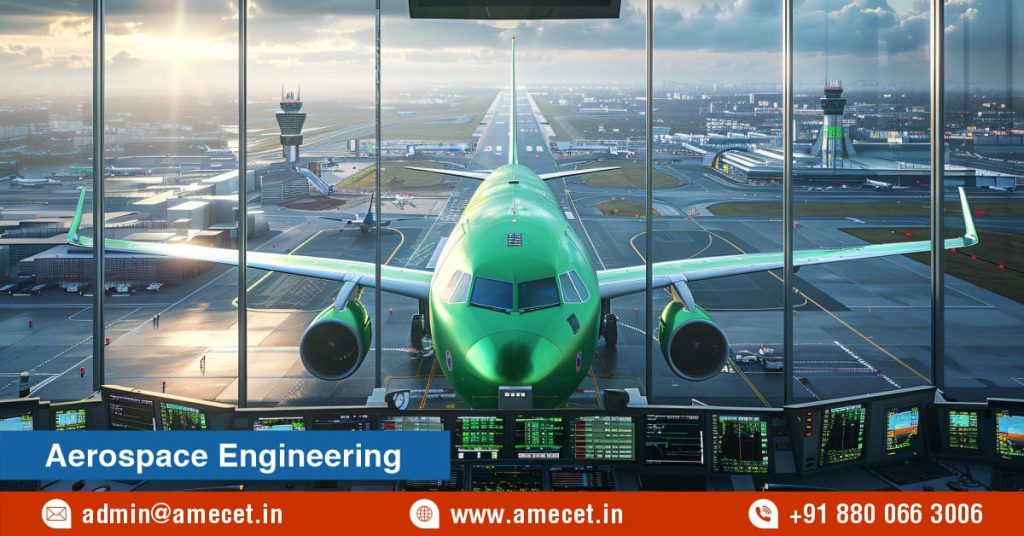What Is Aerospace Engineering?
Posted on : 24 July, 2024 3:27 pm
Aerospace Engineering is a multidisciplinary field that focuses on the design, development, testing, and production of aircraft, spacecraft, and related systems and equipment. It encompasses both aeronautical engineering, which deals with atmospheric flight, and astronautical engineering, which involves space exploration. Aerospace engineers work on cutting-edge technologies to improve the performance, safety, and efficiency of flight vehicles. They apply principles of physics, mathematics, and materials science to innovate and solve complex problems in aviation and space travel, contributing to advancements in commercial aviation, defense, and space exploration.
Page Contents
ToggleCareer Opportunities
Aerospace Engineering offers diverse career opportunities across various sectors. Engineers can work in commercial aviation, developing and improving aircraft for airlines. In defense, they design military aircraft and systems. Space agencies employ engineers to work on spacecraft and satellites. Private aerospace companies focus on space exploration and technology innovation. Additionally, roles are available in research institutions, academic settings, and aerospace consultancy.
Career Opportunities:
- Commercial Aviation: Designing and improving aircraft.
- Defense Sector: Developing military aircraft and systems.
- Space Agencies: Working on spacecraft and satellites.
- Private Aerospace Companies: Space exploration and technology.
- Research Institutions: Conducting aerospace research.
- Academic Positions: Teaching and research in universities.
- Consultancy: Providing expert advice in aerospace projects.
- Government Agencies: Regulating and overseeing aerospace standards.
Challenges and Rewards
Aerospace Engineering presents significant challenges, including complex problem-solving, high-pressure environments, and stringent safety regulations. Engineers must navigate technical difficulties and tight deadlines while adhering to rigorous standards. Despite these challenges, the field offers substantial rewards, such as contributing to groundbreaking innovations, advancing space exploration, and achieving technological milestones. The sense of accomplishment from overcoming challenges and the impact on society provide deep professional satisfaction.
Challenges and Rewards:
- Complex Problem-Solving: Addressing intricate engineering issues.
- High-Pressure Environments: Managing tight project deadlines.
- Stringent Safety Regulations: Ensuring compliance with safety standards.
- Technical Difficulties: Overcoming engineering and design challenges.
- Innovative Contributions: Developing groundbreaking technologies.
- Space Exploration: Advancing space missions and research.
- Technological Milestones: Achieving significant engineering feats.
- Professional Satisfaction: Sense of accomplishment and impact on society.
Impact on Society
Aerospace Engineering has a profound impact on society, driving advancements in technology and improving quality of life. Innovations in aircraft design lead to safer and more efficient air travel. Contributions to space exploration expand our understanding of the universe. Aerospace technologies also enhance communication, weather forecasting, and global positioning systems. Overall, the field significantly influences transportation, safety, and technological progress, benefiting various aspects of daily life.
Impact on Society:
- Safer Air Travel: Improved aircraft design and safety features.
- Efficient Transportation: Enhanced fuel efficiency and performance.
- Space Exploration: Expanding knowledge of space and the universe.
- Communication Advances: Development of satellite technology.
- Weather Forecasting: Improved forecasting through satellite data.
- Global Positioning Systems: Enhancing navigation and tracking.
- Technological Innovation: Driving new technologies and applications.
- Economic Impact: Creating jobs and stimulating industry growth.
Future of Aerospace Engineering
The future of Aerospace Engineering is promising and dynamic, driven by advancements in technology and innovation. Emerging trends include the development of electric and hybrid aircraft for greener aviation. Advances in space technology are pushing the boundaries of exploration and colonization. Autonomous systems and AI are enhancing aircraft operations. Additionally, there is a growing focus on sustainable practices and the integration of advanced materials for better performance.
Future of Aerospace Engineering:
- Electric Aircraft: Development of greener aviation technologies.
- Hybrid Propulsion: Combining traditional and alternative energy sources.
- Space Exploration: Advancements in space travel and colonization.
- Autonomous Systems: Integration of AI in aircraft operations.
- Advanced Materials: Use of innovative materials for improved performance.
- Sustainable Practices: Focus on reducing environmental impact.
- Reusable Rockets: Enhancing cost-efficiency in space missions.
- Commercial Space Travel: Expansion of private space travel opportunities.
Hands-On Experience
Hands-on experience is crucial in Aerospace Engineering, providing practical skills and real-world insights. Internships offer exposure to industry practices and technologies, while lab work in educational settings develops technical proficiency. Participation in projects and simulations helps in applying theoretical knowledge. Working with advanced tools and equipment, as well as engaging in team-based activities, enhances problem-solving abilities and prepares engineers for the challenges of the field.
Hands-On Experience:
- Internships: Industry exposure and practical experience.
- Lab Work: Developing technical skills in educational settings.
- Project Participation: Applying theoretical knowledge to real-world projects.
- Simulations: Using software for practical applications.
- Advanced Tools: Hands-on experience with specialized equipment.
- Team-Based Activities: Collaborating on engineering challenges.
- Field Work: Gaining insights from real-world environments.
- Technical Workshops: Learning from industry experts and professionals.
In conclusion, Aerospace Engineering stands at the forefront of technological innovation and exploration, shaping the future of aviation and space travel. It encompasses diverse disciplines, requires rigorous education and hands-on experience, and offers rewarding career opportunities. As the field advances with emerging technologies, such as electric aircraft and autonomous systems, it continues to impact society profoundly, enhancing transportation, communication, and space exploration. For aspiring engineers, Aerospace Engineering promises a dynamic and fulfilling career, driven by curiosity and the pursuit of groundbreaking achievements.

